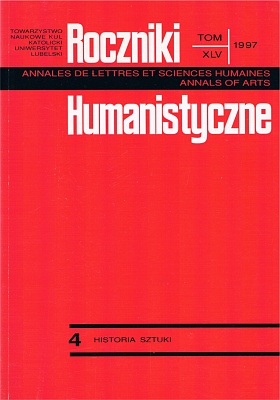Nature in the Fresco Decorations of the Papal Palace in Avignon from the Mid-14th Century. Against the Background of a New Attitude to nature in Italian Society of 13th/14th Centuries
Abstract
The question of nature in the painting of late Gothic, defined as „international Gothic,” has its numerous interpretations. They concentrate around art, in particular around miniature painting derived from Burgundian-Netherlandian circles, when it comes to the geographic location, while in the mid-14th century it begins. It is within this phenomenon in European art regarded as „international” that we find the significant role of Sienese and Florentine painting, and also of those artistic milieus which, although secondarily, took over the experience of Italy and the Netherlands, as for instance, artistic activity linked with the Prague court. The synthesis of those milieus was creative and had a great significance within the whole of late-Gothic art.
The papal court in Avignon possesses already broadly developed research as regards its meaning and role in the history of the Church as well as in the culture and art of the 14th century. It seems, however, that artistic milieu is still a worthwhile object of investigations, Enrico Castelnuovo's thorough monograph inspires us to such investigations, a monograph which embraces the whole of artistic ventures made by the Avignon popes. The issue of understanding nature which the decor of palace's and chapels' chambers unveils has not been studied exhaustively. The present paper may only be an introduction to broader discussions on the role of Avignon painting in the creation of the phenomenon of „international Gothic,” for in terms of chronology it precedes both the Netherlandian artistic activity and other significant centres in Europe. The phenomenon of art synthesis which has been done here thanks to the ambition of popes who invited artists from different corners of Europe, and also thanks to revival of the local milieu; the latter is a bit underestimated, but is a good field of research on nature in the painting of late Middle Ages and protorenesance. Nature has its mature shape here allowing to be enclosed within the criteria of idealism and realism in their literal meaning. On the basis of local works we may study the achievements of the great masters, such as Simone Martini, and other painters, whose works are left in Avignon and which brought them to historical fame; here we find, above all, Matteo Giovanetti. It is E. Castelnuovo who determined authorship of particular fragments, while the present work addresses the differences in the manner of treating nature.
Copyright (c) 1997 Roczniki Humanistyczne

This work is licensed under a Creative Commons Attribution-NonCommercial-NoDerivatives 4.0 International License.





